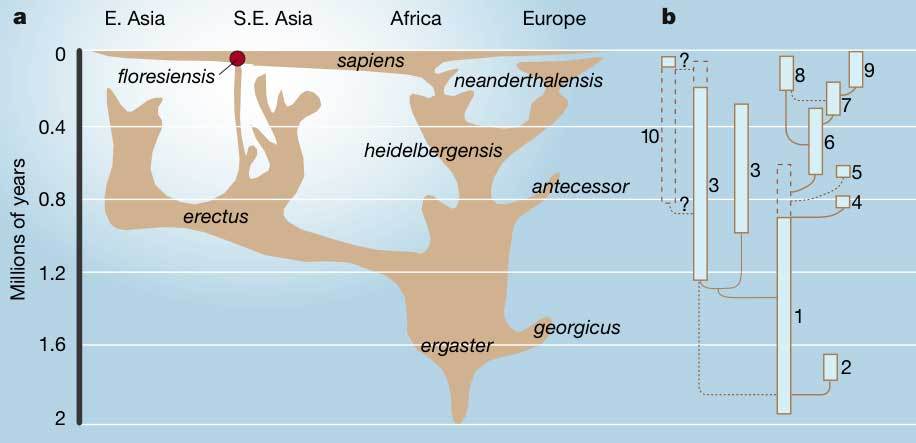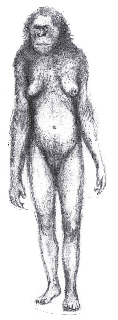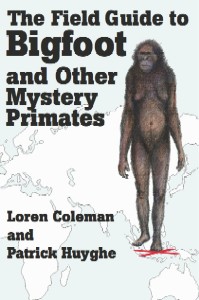The Hobbit Hunt
Posted by: Loren Coleman on March 12th, 2008
The discovery that Homo floresiensis survived until so very recently, in geological terms, makes it more likely that stories of other mythical, human-like creatures such as Yetis are founded on grains of truth….Now, cryptozoology, the study of such fabulous creatures, can come in from the cold.Henry Gee, editor of Nature, “Flores, God and Cryptozoology,” 2004 editorial.
The time is assuredly upon us to expand the Hobbit hunt. The systematic study of Proto-Pygmies in Oceania seems tied to the probable findings of future fossil evidence for Homo floresiensis beyond Flores. What is being discovered in Palau appears to be the latest reinforcement for such thoughts.
The 900-2,800-year-old “insular dwarf” remains from Palau seem to confirm traditions of “Little People” 2 or 3 feet tall from various Pacific islands. The best-known of these Pacific “Little People,” of course, are the Menehune of Hawaii. They are usually described as 2 to 3 feet tall, with short, stout, hairy, and quite muscular bodies, red-skinned faces, big eyes hidden by long eyebrows, low protruding foreheads, and short thick noses.
However, Menehune-like dwarfs have also been reported from other Pacific islands. Thus, six witnesses in a Fijian mid-afternoon encounter in 1975 described seeing eight figures, 2 feet tall and covered with black hair, run and disappear behind some bushes (Fiji Times, July 19, 1975, cited by Loren Coleman and Patrick Huyghe, The Field Guide to Bigfoot and Other Mystery Primates , p. 148).T. Peter Park, 2008

The 3-feet-tall Homo floresiensis, living on Indonesia’s Flores Island, perhaps do exist today as the small, hairy ebu gogo, the Proto-Pygmies of Flores Island folklore. Homo floresiensis, while connected in the media in 2004, with Sumatra’s orang pendek, probably has a more direct link with the more fully hairy hominid examples, such as Sri Lanka’s nittaewo.
The more proper attention would be most important in the direction of Proto-Pygmy folklore. On Flores, for example, the legendary humanlike animal called Ebu Gogo, known for small body size, inarticulate speech and an unusual bipedal gait appears to be a reflection of Homo floresiensis-human encounters.


The male National Geographic painting of the first Homo foresiensis find, compared to Richard Klyver’s sketch of the Flores woman. The first fossil discovery of Homo floresiensis was of a female, not a male.

The front cover of The Field Guide to Bigfoot and Other Mystery Primates is illustrated with a drawing of Homo floresiensis by wildlife artist Richard Klyver, who studied for seven years among chimpanzees in Africa.
Local natives on Flores have one hundred year old legends of a small hairy people, the Ebu Gogo, and clues from these tales will be employed to find new caves to explore for evidence of their former little habitants. While Sumatra’s Orang Pendek has been mentioned in the same context as the media nicknamed ‘Hobbits’ of Flores, the more relevant cryptids are not anthropoids, but the fully manlike ones, such as the Nittaewo, the three feet tall hairy hominids of ancient Ceylon (Sri Lanka) — mentioned by Pliny in the first century — who were said to exist to the end of the 18th Century. It is time to look again at reports of little people, with an eye to the discovery of their subfossil remains and living existence, from Sri Lanka to the South Pacific.Loren Coleman, 2004
About Loren Coleman
Loren Coleman is one of the world’s leading cryptozoologists, some say “the” leading living cryptozoologist. Certainly, he is acknowledged as the current living American researcher and writer who has most popularized cryptozoology in the late 20th and early 21st centuries.
Starting his fieldwork and investigations in 1960, after traveling and trekking extensively in pursuit of cryptozoological mysteries, Coleman began writing to share his experiences in 1969. An honorary member of Ivan T. Sanderson’s Society for the Investigation of the Unexplained in the 1970s, Coleman has been bestowed with similar honorary memberships of the North Idaho College Cryptozoology Club in 1983, and in subsequent years, that of the British Columbia Scientific Cryptozoology Club, CryptoSafari International, and other international organizations. He was also a Life Member and Benefactor of the International Society of Cryptozoology (now-defunct).
Loren Coleman’s daily blog, as a member of the Cryptomundo Team, served as an ongoing avenue of communication for the ever-growing body of cryptozoo news from 2005 through 2013. He returned as an infrequent contributor beginning Halloween week of 2015.
Coleman is the founder in 2003, and current director of the International Cryptozoology Museum in Portland, Maine.










This is brilliant news for the future in terms of credibility given to cryptozoology especially in reference to hominid cryptids.
Cant wait for the next discovery from Flores/Sri Lanka this time dated much more recently.
Great article.
It’s interesting to speculate whether these “little people” could have been widely distributed to Pacific islands by human colonizers, brought along as slaves or a sort of “domestic animal”.
This is a beautiful thing in that we now have hard, physical evidence to support that these creatures lived into relatively recent times. Although these remains are fossils, the ramifications for cryptozoology are considerable. These findings really put into perspective some really quite interesting possibilities for modern day sightings of Proto Pygmies and gives them some scientific foundation, a solid basis of fact on which to work from. Now that we know these pygmies existed, it somewhat expands the plausibility that modern day sightings could derive from a real creature and the question is no longer “does it really exist?”, but rather “has it survived into modern times?”. That is a huge jump in my opinion. The precedence set by other known animals long thought to be extinct being re discovered shows to me that the idea that some of these proto pygmies could be around is not entirely far fetched, although I would like to see more concrete evidence other than sightings that they may be still around.
In light of these sorts of findings and the possible links to Proto Pygmy sightings that Loren mentions, I feel this is fast becoming a potentially very exciting area of cryptozoology. Very thought provoking stuff, Loren. Thanks.
I also find it very intriguing that it seems people have been seeing these “little people” since long before the “Hobbit” fossils were ever even found. These witnesses did not know of this evidence, yet were describing something that in real life could be similar to what the fossils suggest. While not really proving the sightings are genuine, it puts the sightings in a new light for me and makes me wonder. Is it a coincidence that they just happened to describe little people in folklore and sightings before the evidence of real little people was found? Or is it something more? Could the fossils perhaps justify what they have been seeing all along? Interesting to think about.
Hairy as in apes, or hairy as in the perception of caucasians by non-caucasian peoples? Our heavy beards and greater body hair has gotten us called hairy by native American and East Pacific Rim peoples.
So, are the menehune pongids or something like dwarfed Ainu? (the modern Ainu are mixed due to Japanese persecution over the centuries, originally they would have resembled the Saami-like people of the Tarim Basin 4,000 years ago) See the anime’ Princess Mononoke for a Japanese take on that.
Another thing to consider is that people don’t dump their folktales when they move. My grandmother would tease us children by telling us that the cream she set out for the cats was really for the little people. Polynesians having encountered, or having heard of Floriesians might well carry the tales to islands where the latter did not live.
Good post, MYSTERY_MAN:
Couldn’t agree more.
SSCHAPER:
Good point.
I also agree this is a great day for cryptozoology.
Red-faced dwarfs are not only found on Pacific islands. The CFZ collected several stories about them – including some first-hand accounts – during our expedition to Guyana in November. See the expedition blog.
The inhabitants of Flores had mentioned there were small dwarf like individuals to the early European settlers. Perhaps exploring Sri Lanka may have the same result of finding remains of small Hominoids. The Portuguese arrived in Ceylon at the 16th century, so Europeans would have been on the Island period for a brief before the Nittaewo disappeared.
Unfortunately, the island nation is in a 25 year civil war, with the 2002 cease fire being terminated by the government this year. Tourism has been in the decline since 2006 when sporadic fighting and attacks returned late last year, before the end of the cease fire, various national governments recommended that its citizens NOT go to a large national park, which is an attraction to tourists, as there was a small Rebel presence there. I have numerous Sri-Lankan in laws and friends who talk about the deteriorating conditions there and the situation is so tense.
Sigh…. Similar to parts of the Congo
This certainly is an interesting find. My understanding of it is that these skeletons are not thought to be directly related to the flores hominids (or at least, these are seen as definately homo sapiens, whereas a big body of scientific opinion sees flores as a separate descendant of erectus).
Still, its interesting to have yet another example of island dwarfism just to prove its in no way impossible that there might be little humans or other apes running about in various parts of the world. It certainly makes it possible that something (dead or alive) might be found in sri lanka (although that is a very big island, and pliny is always rather a, shall we say, ambiguous source).
Another example that springs to mind are the reputed Taiwanese pygmies (see http://news.bbc.co.uk/1/hi/world/asia-pacific/6217502.stm for an article which tells a bit about them).
Oh, and I recently saw a documentary film about the orang pendek called ‘Short man of the forest: The search for Orang Pendek’ (Banyak Films, 2006) made by a young british anthropologist.
It might be rather hard to get hold of (my university library had a copy), and it doesn’t of course have any real revelations.
It is interesting, however, in showing how amorphous and unstable these myths/legends are, and how they may have a life of their own. Basically, different locals describe the orang pendek in completely different ways (many of which are noting like the now standard little hominid), and it is suggested that nobody really talked about the orang pendek at all until debbie martyr (who comes across as quite odd) made her claims and western investigators got interested.
It was a useful little sceptical-ish brake on my desire to believe..
Wow. And I thought I’d have nothing to say on this one.
Things-in-the-woods: Remember it’s not about belief, it’s about EVIDENCE. I have no desire to believe, but to KNOW.
I know I know, but one thing I thought pretty interesting about the orang pendek was that, when alleged eyewitnesses were brought in from widely separated villages in “the animal’s range,” sequestered from one another, and then brought individually in front of a World Wildlife Fund artist, the resulting “perp sketches” evinced a pretty remarkable consistency. In additon, people given stacks of photos of known primates and sketches of the orang pendek, and asked, with no help, which one is the o.p.?, would either stop on the o.p. (if that were among the ones presented), or would stop at the same photos (of gorillas, if memory serves), and say, pretty consistently, how that animal was similar to the o.p., and how it differed. Then there’s the local headman who has systematically set up baited pit traps, wherever he can, in an indignant effort to show skeptics that HE ISN’T KIDDING!
That said. I wasn’t there; and I sure hope nobody said or showed anything of a “leading” nature to those eyewitnesses. Skepticals are essential wear in these situations. I just think that the NGS-funded search for the o.p. is the kind of thing that is fully justifiable, given the evidence on hand, none of which, granted, amounts to proof. When two Westerners with scientific credentials go on record as having seen the o.p., which I understand is the case, well, I’d hope that would prick ears up.
Indeed, myths and legends are, or should be expected to be, unstable, and have lives of their own. But one must remember that these myths and legends seem to have a tendency to encompass practically every animal indigenous people know about; and that a myth can just as easily be describing an animal they know as it can an animus they made up.
One thing I’d like to see resulting from stuff like this: field biologists going out there with an eye to documenting EVERYTHING THEY SEE. In other words: open minds, researchers. You’re looking for unknown stuff, right? Expanding the frontiers of knowledge, right? Good. Let’s not brand hairy-hominoid sighters as nuts; particularly when they’re scientists. Entomologists, herpetologists, mammalogists, ornithologists, icthyologists, botanists, geologists; they’re all NATURALISTS. They have trained and honed powers of observation that should be brought to bear – it’s a shame if they aren’t now – on EVERYTHING they encounter out there.
In other words, let’s give a woodpecker hunter a real chance to alert us to the sasquatch. Call it Ben Radford’s Dream. 😀
Here’s an illustration of what I’m talking about in my last post, from oranpendek.org:
————————
Without fail, local witnesses and legends describe Orang Pendek as: 1) an ape, 2) about one meter (~ three feet) tall, 3) with a strong chest and arms, 4) short hair covering its body, 5) that walks bipedally (on two legs). Even though its name means “short person”, everyone will tell you that, “Of course it’s not a person, it’s an animal!” Consider orang-utans, whose name means “forest person”. Apes and monkeys have been ascribed human-like qualities throughout history in this region of the world.
————————
Again, someone else is doing the interpretation of the anecdotes, not me. But if that’s indeed what is going on, we may have more company than we think.
(Oh. The “strong chest and arms” seem to have led to researchers considering the gorilla a good candidate among known primates to spark conversation among locals about the o.p., as those features do indeed seem most prominent in the gorilla.)
DWA- Very well said!